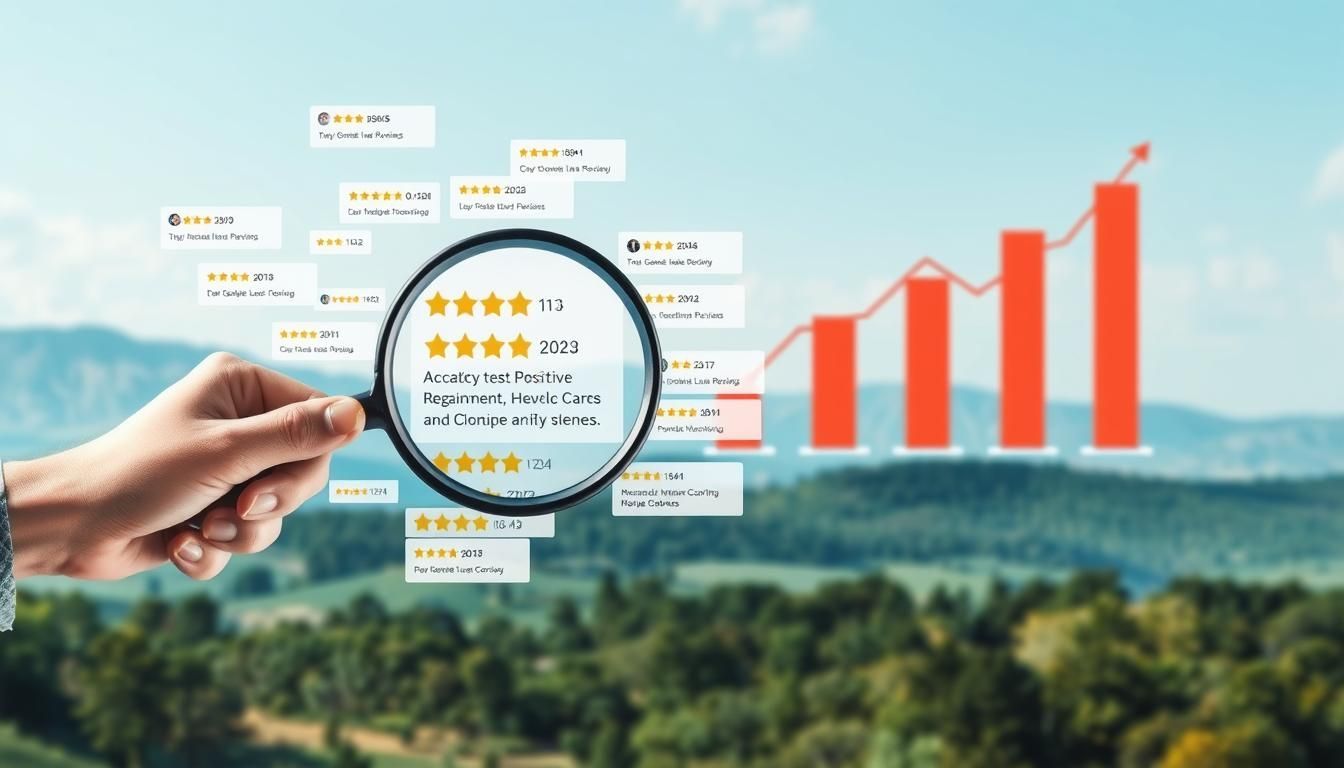
What Should You Do When a Client Leaves a Negative Review?
A negative review can hurt your business a lot. It's key to act fast and well when you get a bad review. This way, you can fix the problem and even grow from it. This article will show you how to handle negative reviews and come out stronger.
Key Takeaways
- Understand the potential impact of negative reviews on your reputation and customer acquisition.
- Stay calm and objective when addressing negative feedback.
- Respond promptly and professionally to acknowledge the concern and offer a solution.
- Take responsibility when appropriate and use constructive criticism to improve your business.
- Monitor your online presence and encourage positive reviews to maintain a balanced reputation.
Understand the Impact of Negative Reviews
Negative reviews can hurt your business a lot. They affect your reputation and how you get new customers. It's key to know how bad feedback can stop new clients from coming.
Reputation Damage
One bad review can harm your online image. People trust online reviews to decide if they should buy from you. A low rating can scare them away. Keeping a good reputation management plan is vital for success.
Loss of Potential Customers
Negative reviews can also mean losing customer acquisition. People might see the bad feedback and go elsewhere. Fixing these reviews quickly and well is important to keep attracting new customers.
"A single negative review can have a significant and lasting impact on a business's reputation and ability to attract new customers."
Knowing how serious negative reviews are is the first step. It helps you manage your online image and keep a good brand. By acting fast, you can show you care about your customers.
Stay Calm and Objective
When you get a negative review, it's key to keep your cool and respond professionally. Getting defensive or emotional can make things worse. Instead, take a moment to think clearly and focus on giving great customer service.
Negative reviews can be tough, but they're a chance to grow and get better. Look at the review from the customer's point of view and any real concerns they have. This helps you make a thoughtful and professional reply.
"The ability to stay calm and objective in the face of criticism is a hallmark of a strong leader. It's a skill that can be developed with practice and a commitment to continuous improvement."
Keeping your emotions in check and responding professionally shows you value feedback. It also shows you're dedicated to excellent customer service. This not only fixes the issue but also boosts your brand's image and gains trust.
Respond Promptly and Professionally
When a customer leaves a negative review, it's key to respond fast and well. This shows you care about solving problems and giving great service. It's a chance to show you're committed to making things right.
Acknowledge the Concern
First, understand what the customer is saying and show you get it. Express empathy and let them know you are listening. This shows you value their feedback and want to fix their issue.
Offer a Solution
Then, give a clear and simple fix or explain how you'll solve the problem. Suggest a way to make things right, like a refund or a replacement. This can change a bad experience into a good one, showing you're all about making customers happy.
"A prompt and professional response can turn a negative review into an opportunity to showcase your commitment to customer service."
Quick and professional responses can lessen the harm of a bad review. They can even make things better. This helps keep your online image strong and builds trust with your customers.
Take Responsibility When Appropriate
When you get a negative review, it's key to handle it with accountability. Sometimes, owning up to the problem can really help fix things. Saying sorry and showing you're serious about fixing it can show you care.
By owning the issue, you show your clients you value their feedback. This makes you look good and shows you're all about making things right. It's a big step towards customer trust and a better experience for everyone.
"Owning up to mistakes and taking responsibility is a sign of strength, not weakness. It shows your customers that you care about their satisfaction and are dedicated to continuous improvement."
But, don't overdo it with self-blame. Look at the situation clearly and see if the review is fair. If it's not, you can still try to fix things. Doing this shows you're serious about accountability and conflict resolution.
Request to Resolve the Issue Privately
When you face a negative review, trying to solve it offline is often the best move. This way, you can have a more open and effective talk with the customer. You can work together to find a solution that both of you can agree on, away from public eyes. Keeping the issue private is key to managing your reputation well.
Ask the customer to move the conversation to a private setting. Show them you want to understand their concerns and fix the problem. This shows you're serious about great customer service and ready to make things right if you've made a mistake. By talking privately, you can solve the issue without hurting your online image more.
"The best way to resolve this issue would be to discuss it privately, where we can work together to find a solution that meets your needs. I'm committed to ensuring you're fully satisfied with our services, and I believe we can find a resolution that works for both of us."
Asking to solve the issue privately shows you care about their feedback and are ready to help. This can help calm the situation and keep your business's good name intact.
Negative Review: Embrace Constructive Criticism
Getting a negative customer feedback can be tough, but it's a chance for business improvement and growth mindset. Negative reviews might be hard to swallow, but they often have useful insights. These insights can help you make your products or services better and serve your clients better.
Don't just ignore or defend against the criticism. Take time to really look at the feedback. Look for any constructive criticism that can help you make your business stronger. This could mean improving customer service, making your offerings better, or fixing specific problems your clients have faced.
"Negative feedback is a gift. It's an opportunity to learn and grow." - Unknown
By adopting a growth mindset, you can use negative reviews to spark positive changes. Talk about the feedback with your team, get more ideas, and make a plan to fix the problems. This shows you care about making your customers happy and helps your business grow and succeed in the long run.
Every problem is a chance to get better. View negative reviews with an open and curious mind. Use them to improve your customer experience and drive business improvement.
Monitor and Manage Online Presence
In today's digital world, keeping a good online image is key for businesses of all sizes. It's important to watch your online presence and reviews closely. This way, you can quickly deal with any bad feedback.
Encourage Positive Customer Reviews
One good way to handle your online image is to ask happy customers for reviews. Good reviews can balance out the bad ones and show your brand's trustworthiness. Ask your happy clients to share their positive experiences on sites like Google, Yelp, or specific industry sites.
"Positive online reviews can be a powerful tool in building trust and credibility with potential customers." - John Smith, Reputation Management Expert
By actively managing your online reputation and encouraging positive customer reviews, you can keep a strong review management strategy. This strategy helps attract new customers and keep the ones you have.
Remember, keeping an eye on your online presence is a constant job. Always be ready to respond to any negative feedback. Keep working to improve the customer experience. This approach will help you keep a good online reputation and build strong customer relationships.
Learn from the Experience
Getting a negative review can be tough, but it's also a chance for business improvement. By looking at the feedback, you can find ways to make your customer experience and service quality better. This can turn a setback into a valuable learning moment.
Start by carefully reading the negative review and thinking about what the customer said. What problems did they face? What could your team have done differently? Look for common issues that might show a bigger problem in how you operate or serve customers.
Identify Areas for Improvement
Use the negative review to check your business's good and bad points. Find out where you need to focus, like improving customer service, making products better, or making communication smoother. This honest look will help you make a plan to fix the problems that made the customer unhappy.
"Negative feedback, although unpleasant, can be a valuable resource for improving your business. Embrace it as an opportunity to better understand your customers and make meaningful changes that will enhance their overall experience."
By seeing negative reviews as chances for growth, you can make your business better. Make the needed changes, watch how they work, and keep making your service even better. This way, you'll give your customers an amazing customer experience and service quality.
Prevent Future Negative Reviews
It's important to focus on making customers happy to avoid bad reviews. Improve your customer service and be clear about what you offer. This way, you can keep clients happy and meet their needs better. Being good at proactive communication and service excellence helps a lot.
Enhance Customer Service
Always aim to give your customers the best experience. Answer their questions fast and solve problems quickly. Also, try to do more than they expect. Training your staff well and letting them help customers personally can really help.
Set Clear Expectations
Be open and clear from the start. Tell your clients what you can do, when you can do it, and any possible issues. Being upfront can prevent misunderstandings and keep clients happy.
"The key to preventing future negative reviews is to proactively address customer needs and maintain open communication throughout the entire client journey."
By focusing on customer satisfaction, using proactive communication, and aiming for service excellence, you can lower the chance of bad reviews. This helps build strong, positive relationships with your clients.
Consider Legal Action as a Last Resort
In extreme cases, if a review is false, misleading, or defamatory, you might think about legal action. But, it's important to think carefully about the risks and benefits. Legal battles can take a lot of time and money.
Defamation cases are complex and need a good lawyer to understand. They help you know what to expect in your area. Protecting your business's reputation is key, but legal steps should be a last choice. They should only be taken when all else fails.
Handling negative reviews well and quickly is usually best. Keep your online image strong, ask for positive feedback, and learn from mistakes. This way, you can avoid legal trouble and keep your reputation safe.
FAQ
What should you do when a client leaves a negative review?
If a client leaves a negative review, stay calm and think clearly. Understand how it affects your business and future customers. Then, respond quickly and professionally, showing you care and want to fix the problem.
If it's right, own up to the mistake and try to solve it quietly. Use the feedback to make your business better. This way, you can grow from the negative review.
How can you understand the impact of negative reviews?
Negative reviews can hurt your business a lot. They can damage your reputation and scare off new customers. It's key to see how far-reaching the harm can be.
Why is it important to stay calm and objective when facing a negative review?
Keeping calm and being objective is crucial when facing a negative review. Avoid getting defensive or emotional. Instead, take a moment to think it through calmly.
How should you respond to a negative review?
It's important to answer negative reviews quickly and professionally. Show you're listening and offer a solution. This shows you care about your customers and want to make things right.
When should you take responsibility for a negative review?
Sometimes, you should own up to the problem. Saying sorry sincerely can help rebuild trust. It shows you're serious about fixing the issue.
How can you request to resolve the issue privately?
If you can, ask to solve the problem privately. This lets you work directly with the customer without more public criticism. It helps avoid things getting worse.
How can you embrace constructive criticism in a negative review?
Negative reviews are chances to grow and improve. Look for useful feedback to make your business better. Use it to serve your clients even better.
How can you monitor and manage your online presence?
Keep an eye on your online presence and reviews. Also, encourage happy customers to share their positive experiences. This can balance out the negative ones and keep your reputation strong.
How can you learn from a negative review experience?
Study the negative review to learn. Find out where you can improve, like service or quality. Make the needed changes to avoid similar problems in the future.
How can you prevent future negative reviews?
Work hard to avoid future negative reviews. Improve your service and set clear expectations. Always try to meet or exceed customer expectations and solve problems quickly.
When should you consider legal action for a negative review?
If a review is false or harmful, you might think about legal action. But, think carefully about the risks and costs. Legal battles can be long and expensive.






